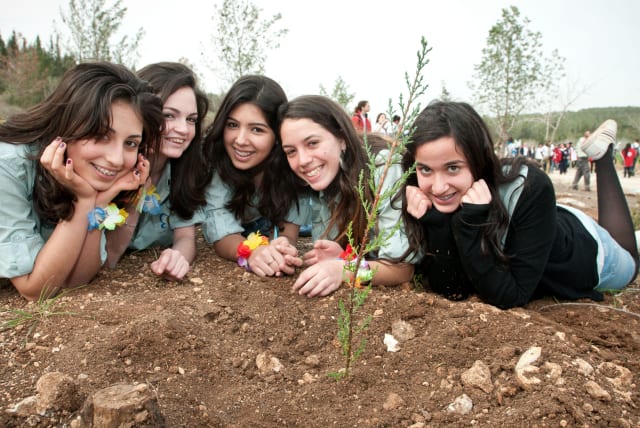Tu Bishvat: Happy new year – if you're a tree

Tu Bishvat reminds us of our responsibility to the environment – that we should cry out against the enormity of the destruction of rain forests and the degradation of God’s world.
From the very beginning of Creation, the Holy One was occupied with the planting of trees. As it is written: “God planted a garden in Eden” (Gen. 2:8).
Every year, on the Hebrew date of Tu Bishvat, we celebrate a strange holiday, the New Year of Trees. The name Tu Bishvat is a short form of “15th of Shvat” (tet = 9 and vav = 6). This year, Tu Bishvat falls on February 6. It also has other names – Chag Ha’ilanot, the Festival of Trees; and Chag Haperot, the Festival of Fruit.
In winter, there is usually heavy rain and some storms. Vegetation is dormant. Except for the olive, the cypress, the carob and the pine, the trees are leafless, the fields newly plowed and sown. But during Shvat, nature rouses itself. Meadows are carpeted with bright red anemones, cyclamens peep from rock crevices. Trees begin to blossom. The almond (shaked) is the first, bedecking itself with white flowers.
Tu Bishvat: What is the value of trees in Judaism?
The Talmud and the Midrash are emphatic about the value of trees. “Man’s life depends on the tree”; “All the trees were created for the use and enjoyment of living beings”; “It is forbidden to live in a city that has no gardens and greens.” The Torah is compared to a tree: “For it is a tree of life....” Trees were given human characteristics: the cedar symbolizing courage and strength; the olive – wisdom; the grapevine – joy and childbearing; the palm – beauty and stateliness.
Thus it is easy to understand the holiday of Tu Bishvat, the day when trees are judged... which trees will flourish and grow tall; which will wither and shrink; which to be struck by lightning and which to withstand all danger.
On the ancient Jewish calendar, the 15th of Shvat became the date for calculating the beginning of the agricultural cycle with respect to biblical tithes and other precepts dependent on the Land of Israel.
The customs of Tu Bishvat are few but delightful. Holding a Tu Bishvat Seder is not commanded in the Torah. The idea began in Safed in the 1500s as a celebration of the Creation, and it is modeled after the Passover Seder. Fifteen kinds of fruit and nuts are eaten, and four cups of wine are drunk. Traditionally, the first cup is white wine; then white mixed with a bit of red; the third cup is red mixed with a bit of white; and the fourth cup is pure red wine, symbolizing the four seasons. The table is set with fruit, wine and a loaf of bread. We read a selection of prayers, poems and blessings referring to trees and fruit and the earth’s fertility.
Tree planting ceremonies, especially by children, are traditional on Tu Bishvat in Israel, where the soil is holy. At the dawn of Creation, God placed Adam in the Garden of Eden to till it and tend it. We are therefore commanded to take care of the world and be its stewards.
Tu Bishvat also reminds us of our responsibility to the environment – that we should cry out against the enormity of the destruction of rain forests and the degradation of God’s world. ■
The writer is the author of 14 books. Her latest novel is Searching for Sarah. Her personal favorite, Esther – a Jerusalem Love Story, has just been republished by Chaim Mazo. dwaysman@gmail.com
Jerusalem Post Store
`; document.getElementById("linkPremium").innerHTML = cont; var divWithLink = document.getElementById("premium-link"); if (divWithLink !== null && divWithLink !== 'undefined') { divWithLink.style.border = "solid 1px #cb0f3e"; divWithLink.style.textAlign = "center"; divWithLink.style.marginBottom = "15px"; divWithLink.style.marginTop = "15px"; divWithLink.style.width = "100%"; divWithLink.style.backgroundColor = "#122952"; divWithLink.style.color = "#ffffff"; divWithLink.style.lineHeight = "1.5"; } } (function (v, i) { });

